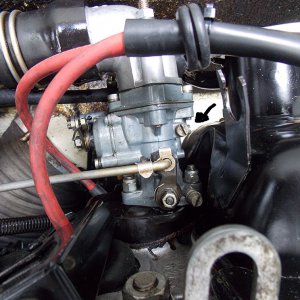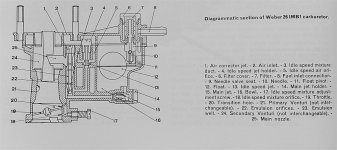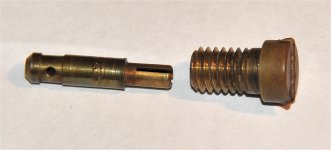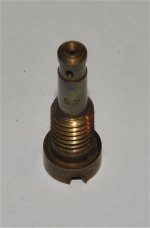Ok no problems.
Firstly leave the 123 distributor in place don't undo the nut that holds it in place.
When removing the rocker box cover firstly it should have lock nuts which have a little plastic insert inside them, that are designed to hold the nut in place in case the engine vibration loosens them off. Often blue. What I do is count how many 360 degree revolutions of the nut it takes for the nut to come off the end of the thread on the top of the block. The reason I do this is so that when putting them back on you don't over tighten the nuts, as it is quite common for the rocker box cover to distort through being tightened too much and this causes leaks around the gasket. So by counting how many rotations to take off you know exactly how many to do it up again. It really is not done up that tight just nipped up to gently squeeze down on the gasket. It should also have little brown washers that act as a seal around the thread.
On the pulley that has the timing marks on rotate it around so that the TDC mark lines up with the little arrow on the crankcase. On the rockers you obviously have an exhaust and inlet valve for each piston. When you rotate the pulley to match the TDC mark, your rockers on one cylinder should be at a state of change over exhaust about to shut inlet about to open, both will have no movements on the rockers, you can move the engine back and forth on the dynamo nut to get to this change over phase. Once you have found this position if you then go to the other cylinder both rockers should have a tiny movement up and down on the end of the valve stems, that gap up and down is your .15mm valve clearance. This is the cylinder about to fire.
If when you do this first time around and it is cylinder two, furthest away from you, about to fire. Then rotate the engine through 360 degrees so TDC again aligns with the little arrow on the crankcase. When you have got to the stage where number one cylinder is in "about to fire state" ie rocker movement. Take a look at where the rotor arm is pointing on the distributor, it should line up approximately with the number 1 HT lead on the distributor cap, which in turn should connect to the spark plug nearest to you when looking in the engine bay.
Obviously you can check the valve clearances when cold at the same time. I would set them on a cylinder first, then rotate through 360 do the other cylinder, then rotate through 360 again and double check, then through 360 again and double check again.
You should be able to lift the rocker box cover high enough to get it up a little then just run a screw driver or knife around under the gasket to free it away from the block without damaging the gasket. You really don't need gasket sealant on the rocker box, so long as it not over tight it should provide a nice seal. I wouldn't run the engine without the rocker box in place, it could get a bit messy/oily. I have used my rocker box gasket off and on multiple times without any probs.
Have ago and let me know how you get on.
Tony







